A Study on Optimal Design Process of Dual Rotor Axial-Flux Permanent Magnet Synchronous Motors
Abstract
1. Introduction
2. Robot Joint Motor and Axial Flux Permanent Magnet Synchronous Motor
2.1. Motor Characteristics for Robot Joints
2.2. Axial Flux Permanent Magnet Motor Characteristics
3. Dual Rotor Axial Flux Permanent Magnet Synchronous Motor Design
3.1. Target RFPM Synchronous Motor
3.2. AFPM Motor Design
3.3. Dual Rotor Type AFPM Synchronous Motor Design
4. Optimal Design Process with Mixed Variables (Integer and Real Number)
4.1. Sequential Approximate Optimization Techniques Based on Progressive Meta-Model
4.2. Optimal Design Process with Mixed Variables (Integer and Real Number)
5. Optimal Design of Dual Rotor AFPM Motor
5.1. Constructing an Optimal Design Model
5.2. Primary Optimization of Integer Design Variables with Design of Experiment-Based Effect Analysis
5.3. Final Model Selection and Performance Comparison
6. Conclusions
Author Contributions
Funding
Data Availability Statement
Conflicts of Interest
References
- Wu, S.-H.; Hong, X.-S. Integrating Computer Vision and Natural Language Instruction for Collaborative Robot Human-Robot Interaction. In Proceedings of the 2020 International Automatic Control Conference (CACS), Hsinchu, Taiwan, 4–7 November 2020; pp. 1–5. [Google Scholar]
- Shin, D.-Y.; Jung, M.-J.; Lee, K.-B.; Lee, K.-D.; Kim, W.-H. A Study on the Improvement of Torque Density of an Axial Slot-Less Flux Permanent Magnet Synchronous Motor for Collaborative Robot. Energies 2022, 15, 3464. [Google Scholar] [CrossRef]
- Liu, L.; Guo, F.; Zou, Z.; Duffy, V.G. Application, development and future opportunities of collaborative robots (cobots) in manufacturing: A literature review. Int. J. Hum. Comput. Interact. 2022, 1–18. [Google Scholar] [CrossRef]
- Hentout, A.; Aouache, M.; Maoudj, A.; Akli, I. Human–robot interaction in industrial collaborative robotics: A literature review of the decade 2008–2017. Adv. Robot. 2019, 33, 764–799. [Google Scholar] [CrossRef]
- Sherwani, F.; Asad, M.M.; Ibrahim, B.S.K.K. Collaborative robots and industrial revolution 4.0 (ir 4.0). In Proceedings of the 2020 International Conference on Emerging Trends in Smart Technologies (ICETST), Karachi, Pakistan, 26–27 March 2020; pp. 1–5. [Google Scholar]
- Haddadin, S.; Albu-Schäffer, A.; Hirzinger, G. Safe Physical Human-Robot Interaction: Measurements, Analysis and New Insights. In Proceedings of the 13th International Symposium of Robotics Research (ISRR2007), Hiroshima, Japan, 26–29 November 2007. [Google Scholar]
- Veronneau, C.; Denis, J.; Lhommeau, P.; St-Jean, A.; Girard, A.; Plante, J.-S.; Bigue, J.-P.L. Modular Magnetorheological Actuator with High Torque Density and Transparency for the Collaborative Robot Industry. IEEE Robot. Autom. Lett. 2022, 8, 896–903. [Google Scholar] [CrossRef]
- Duong, M.-T.; Luu, T.-P.; Do, T.D.; Perriard, Y. Design of High Torque Density Permanent Magnet Motors and Drives for Collaborative Robot Applications. In Proceedings of the 2021 24th International Conference on Electrical Machines and Systems (ICEMS), Gyeongju, Republic of Korea, 31 October–3 November 2021. [Google Scholar]
- Chen, Y.; Pillay, P.; Khan, A. PM Wind Generator Topologies. IEEE Trans. Ind. Appl. 2005, 41, 1619–1626. [Google Scholar] [CrossRef]
- Profumo, F.; Shang, Z.; Tenconi, A. Axial Flux Machines Drives; A New Viable Solution for Electric Cars. IEEE Trans. Ind. Electron. 1997, 44, 39–54. [Google Scholar] [CrossRef]
- Messina, G.; Tamburo, E.; Bella, D.; Morici, L. HTS Axial Flux Permanent Magnets Electrical Machine Prototype: Design and Test Results. IEEE Trans. Appl. Supercond. 2019, 29, 5. [Google Scholar] [CrossRef]
- Alvarez, A.; Suarez, P.; Caceres, D.; Cordero, E.; Ceballos, J.-M.; Perez, B. Disk-shaped Superconducting rotor under a rotating magnetic field: Speed dependence. IEEE Trans. Appl. Supercond. 2005, 15, 2. [Google Scholar] [CrossRef]
- Pippuri, J.; Manninen, A.; Keranen, J.; Tammi, K. Torque density of radial, axial and transverse flux permanent magnet machine topologies. IEEE Trans. Magn. 2013, 49, 2339–2342. [Google Scholar] [CrossRef]
- Qu, R.; Aydin, M.; Lipo, T.A. Performance comparison of dual-rotor radial-flux and axial-flux permanent-magnet BLDC machines. In Proceedings of the IEEE International Electric Machines and Drives Conference, Madison, WN, USA, 1–4 June 2003; pp. 1948–1954. [Google Scholar]
- González-Paradaa, A.; Guía, M.; Ibarraa, O. Development of axial flux HTS induction motors. Int. Meet. Electr. Eng. Res. 2012, 35, 4–13. [Google Scholar] [CrossRef]
- Gieras, J.F.; Wang, R.J.; Kamper, M.J. Axial Flux Permanent Magnet Brushless Machines; Springer: Cham, Switzerland, 2008. [Google Scholar]
- Pyo, H.-J.; Lee, K.; Min, J.-Y.; Hong, M.-K.; Kim, W.-H. Eddy Current Loss Reduction in Axial-Flux Motors Using 3D Printing. Energies 2023, 16, 1318. [Google Scholar] [CrossRef]
- Aydin, M.; Huang, S.; Lipo, T.A. Torque quality and comparison of internal and external rotor axial flux surface-magnet disc machines. IEEE Trans. Ind. Electron. 2006, 53, 822–830. [Google Scholar] [CrossRef]
- Bi, Y.; Pei, Y.; Chai, F. A novel axial flux interior permanent magnet motor with high torque density. In Proceedings of the 2019 22nd International Conference on Electrical Machines and Systems (ICEMS), Harbin, China, 11–14 August 2019; pp. 1–5. [Google Scholar]
- Aydin, M.; Gulec, M. A new coreless axial flux interior permanent magnet synchronous motor with sinusoidal rotor segments. IEEE Trans. Magn. 2016, 52, 1–4. [Google Scholar] [CrossRef]
- Rahim, N.A.; Ping, H.W.; Tadjuddin, M. Design of axial flux permanent magnet brushless DC motor for direct drive of electric vehicle. In Proceedings of the IEEE General Meeting Power & Energy Society, Tampa, FL, USA, 24–28 June 2007; pp. 1–6. [Google Scholar]
- Caricchi, F.; Capponi, F.G.; Crescimbini, F.; Solero, L. Experimental study on reducing cogging torque and no-load power loss in axial-flux permanent-magnet machines with slotted winding. IEEE Trans. Ind. Appl. 2004, 40, 1066–1075. [Google Scholar] [CrossRef]
- Watanabe, A.; Saito, T.; Ueno, T.; Tsuruta, H.; Nakamura, Y. Thin and High-Torque Axial Gap Motor Using Soft Magnetic Powder Cores. SEI Tech. Rev. 2018, 86, 106–112. [Google Scholar]
- Cavagnino, A.; Lazzari, M.; Profumo, F.; Tenconi, A. A comparison between the axial flux and the radial flux structures for PM synchronous motors. IEEE Trans. Ind. Appl. 2002, 38, 1517–1524. [Google Scholar] [CrossRef]
- Capponi, F.G.; De Donato, G.; Caricchi, F. Recent advances in axial-flux permanent-magnet machine technology. IEEE Trans. Ind. Appl. 2012, 48, 2190–2205. [Google Scholar] [CrossRef]
- Hemeida, A.; Taha, M.; Abdallh, A.A.E.; Vansompel, H.; Dupré, L.; Sergeant, P. Applicability of Fractional Slot Axial Flux Permanent Magnet Synchronous Machines in the Field Weakening Region. IEEE Trans. Energy Convers. 2017, 32, 111–121. [Google Scholar] [CrossRef]
- Zhang, B.; Andreas, S.; Doppelbauer, M. Development of a novel yokeless and segmented armature axial flux machine based on soft magnetic powder composites. In Proceedings of the World PM 2016 Congress and Exhibition, Hamburg, Germany, 9–13 October 2016; Volume 63, pp. 2062–2071. [Google Scholar]
- Arand, S.J.; Ardebili, M. Multi-objective design and prototyping of a low cogging torque axial-flux PM generator with segmented stator for small-scale direct-drive wind turbines. IET Electr. Power Appl. 2016, 10, 889–899. [Google Scholar] [CrossRef]
- Woolmer, T.J.; McCulloch, M.D. Axial flux permanent magnet machines: A new topology for high performance applications. In Proceedings of the IET Hybrid Vehicle Conference, Coventry, UK, 12–13 December 2006; Volume 2006, pp. 27–42. [Google Scholar]
- Paiva, R.D.; Silva, V.C.; Nabeta, S.I.; Chabu, I.E. Magnetic topology with axial flux concentration: A technique to improve permanent-magnet motor performance. J. Microw. Optoelectron. Electromagn. Appl. 2017, 16, 881–899. [Google Scholar] [CrossRef]
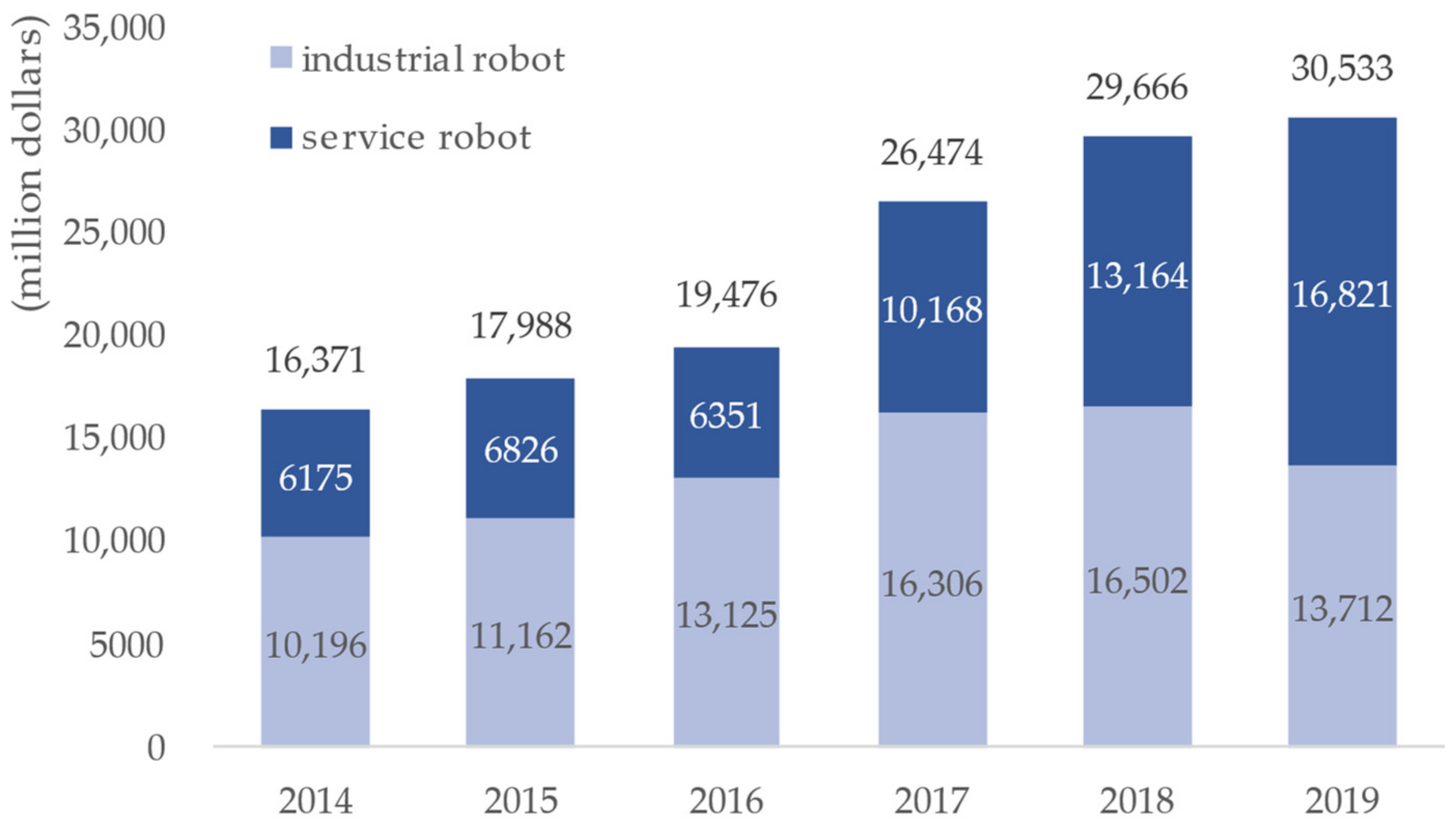
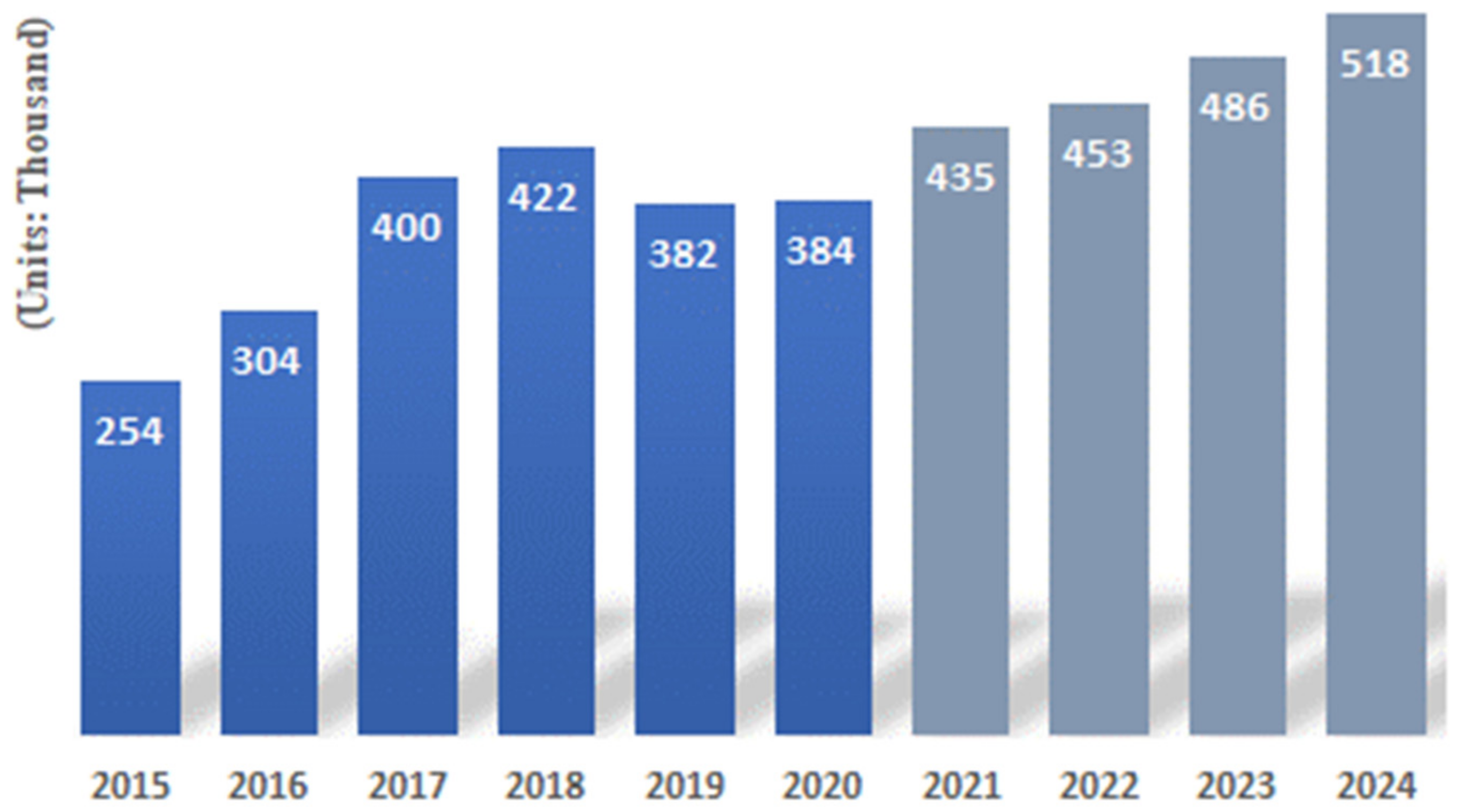
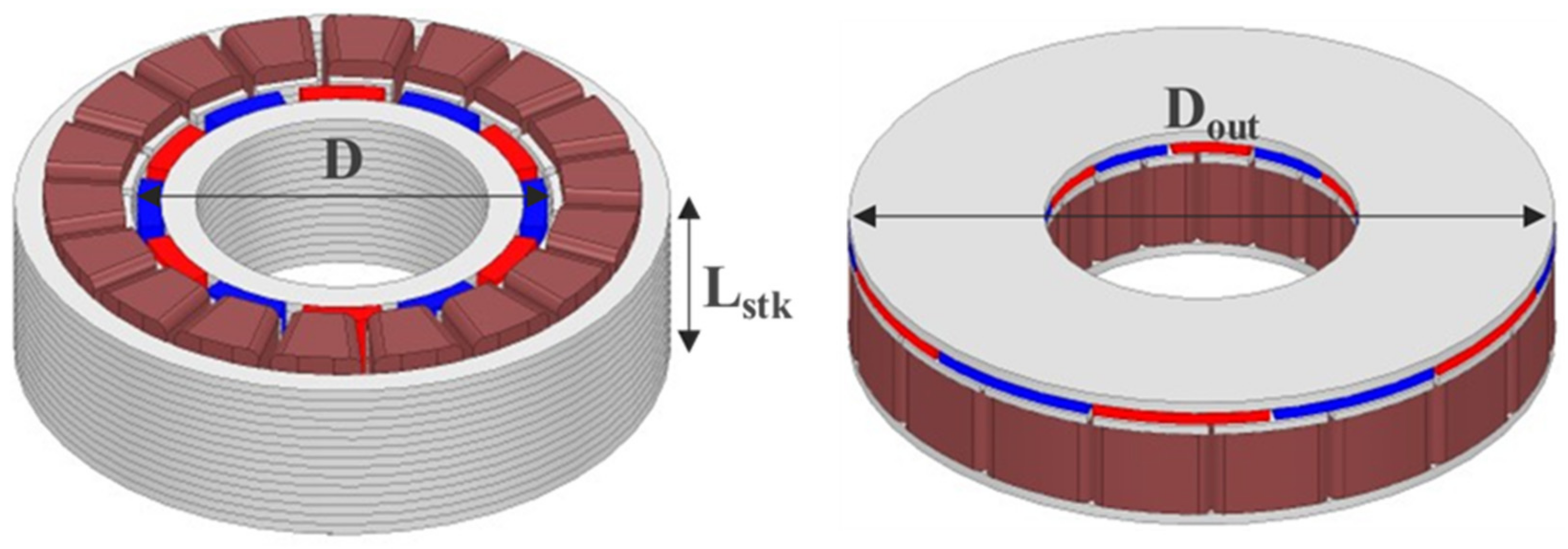
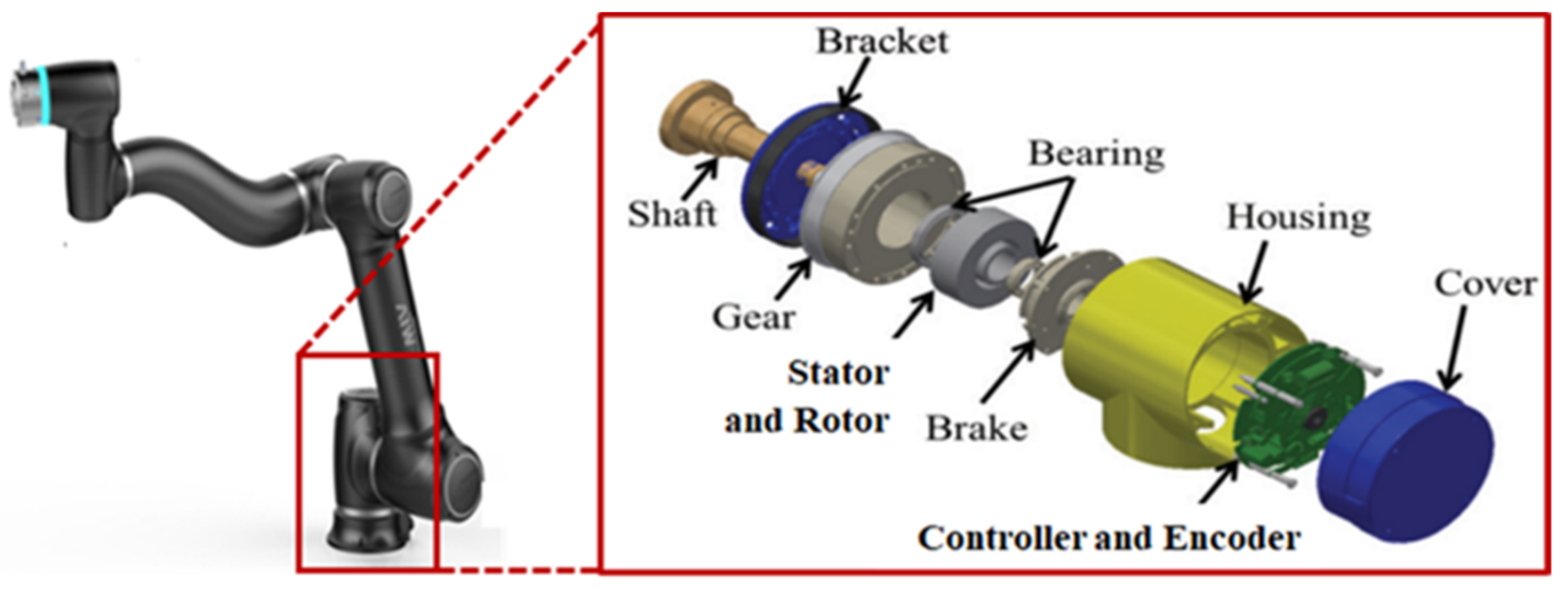
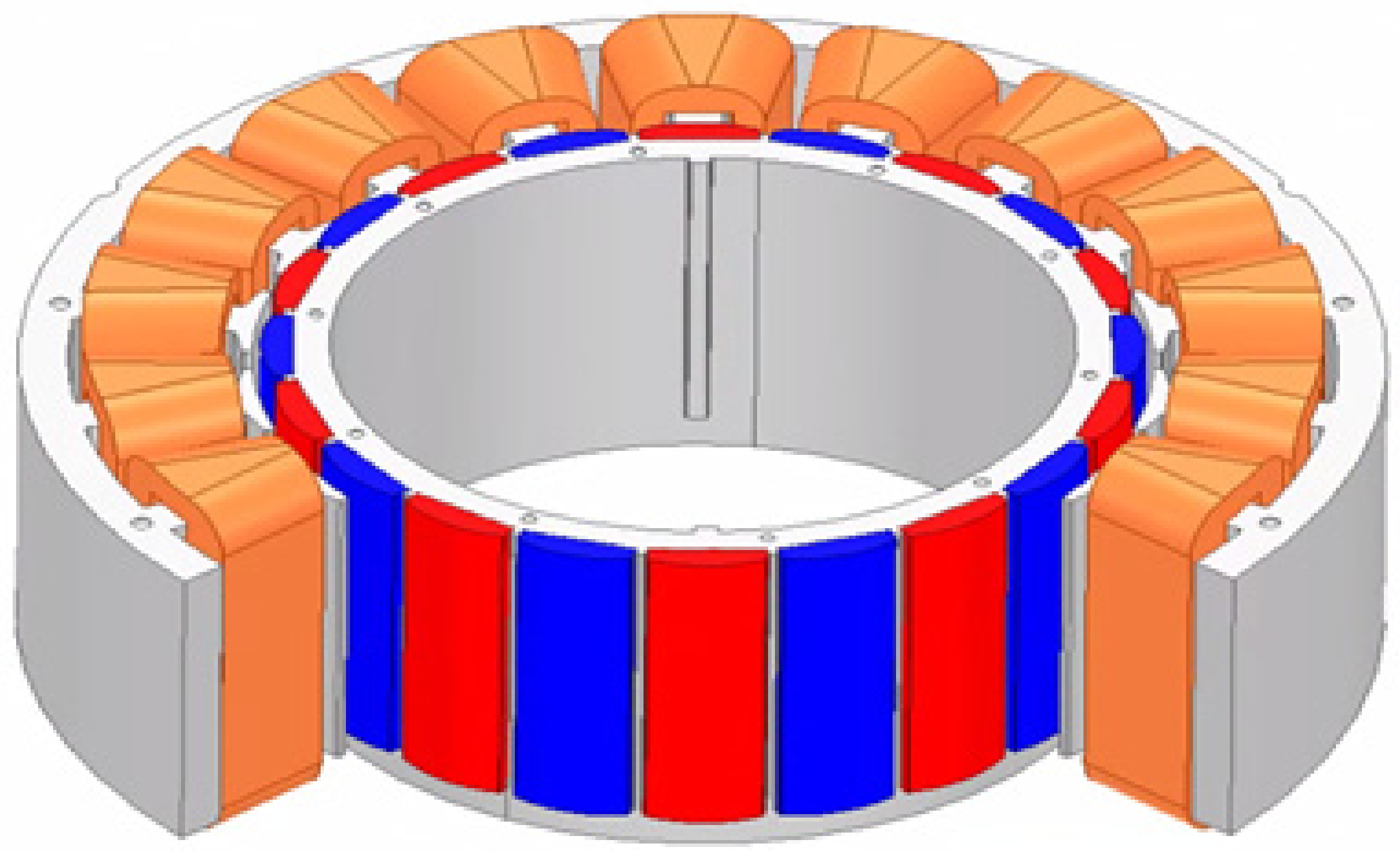
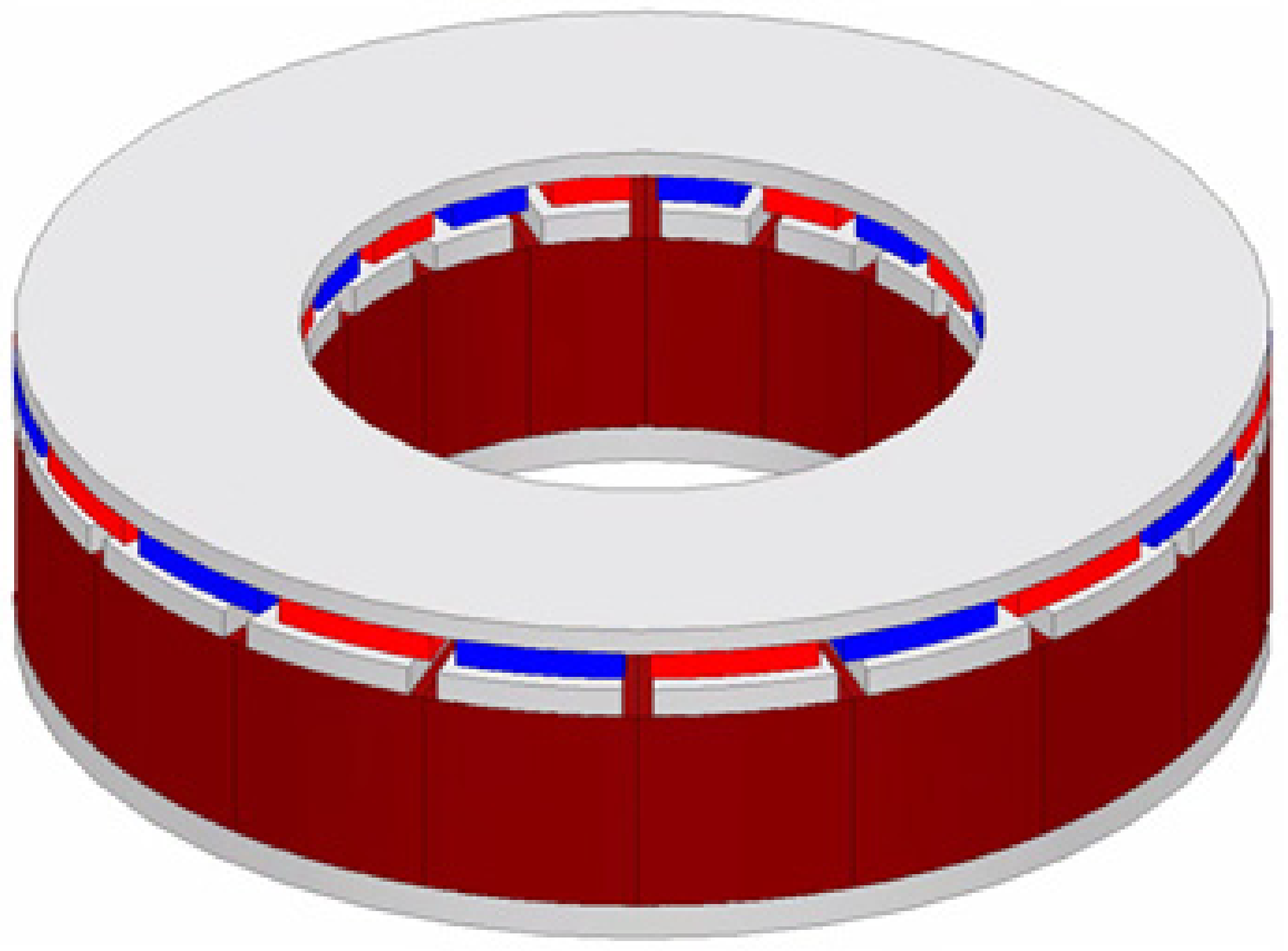
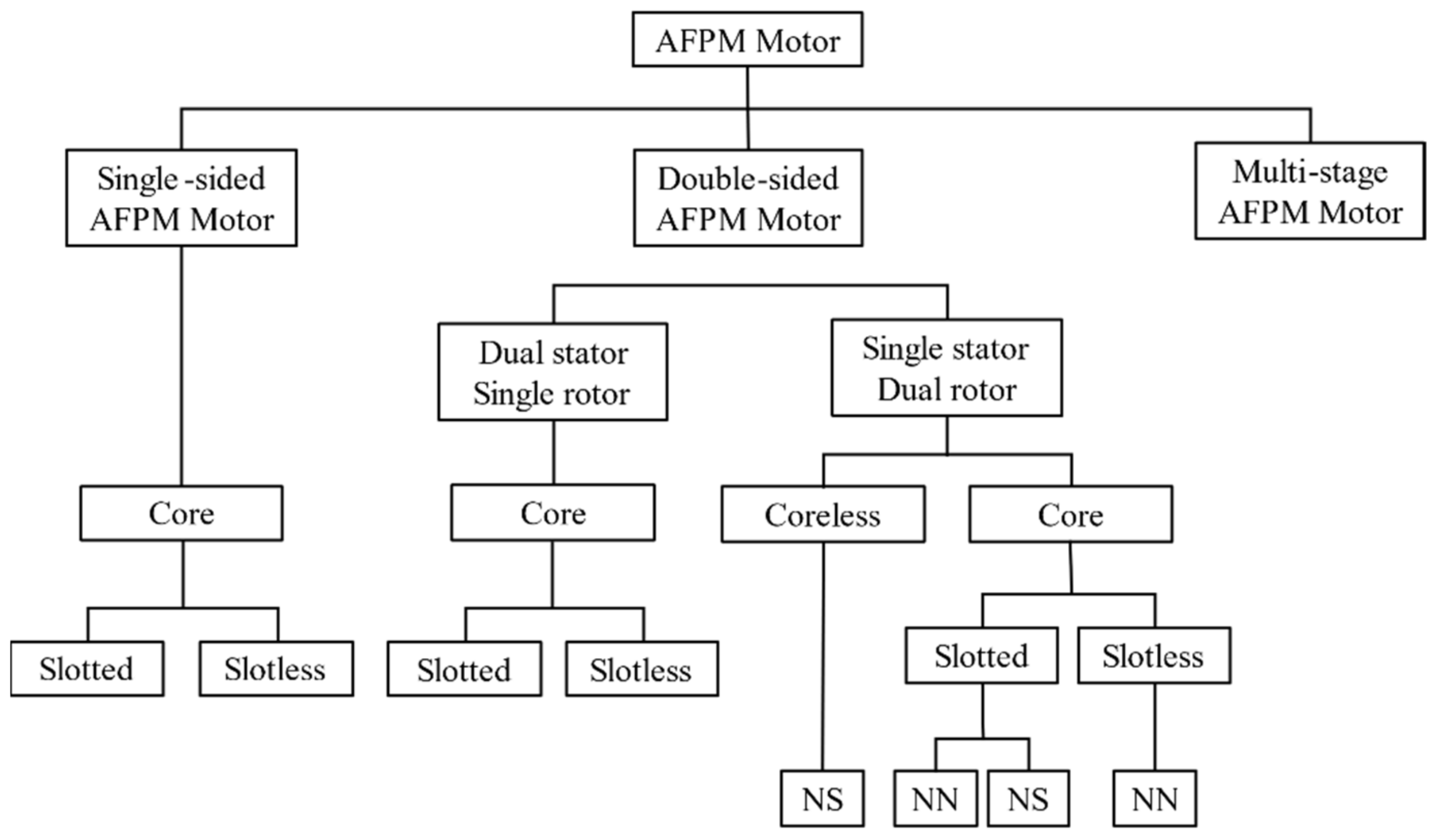
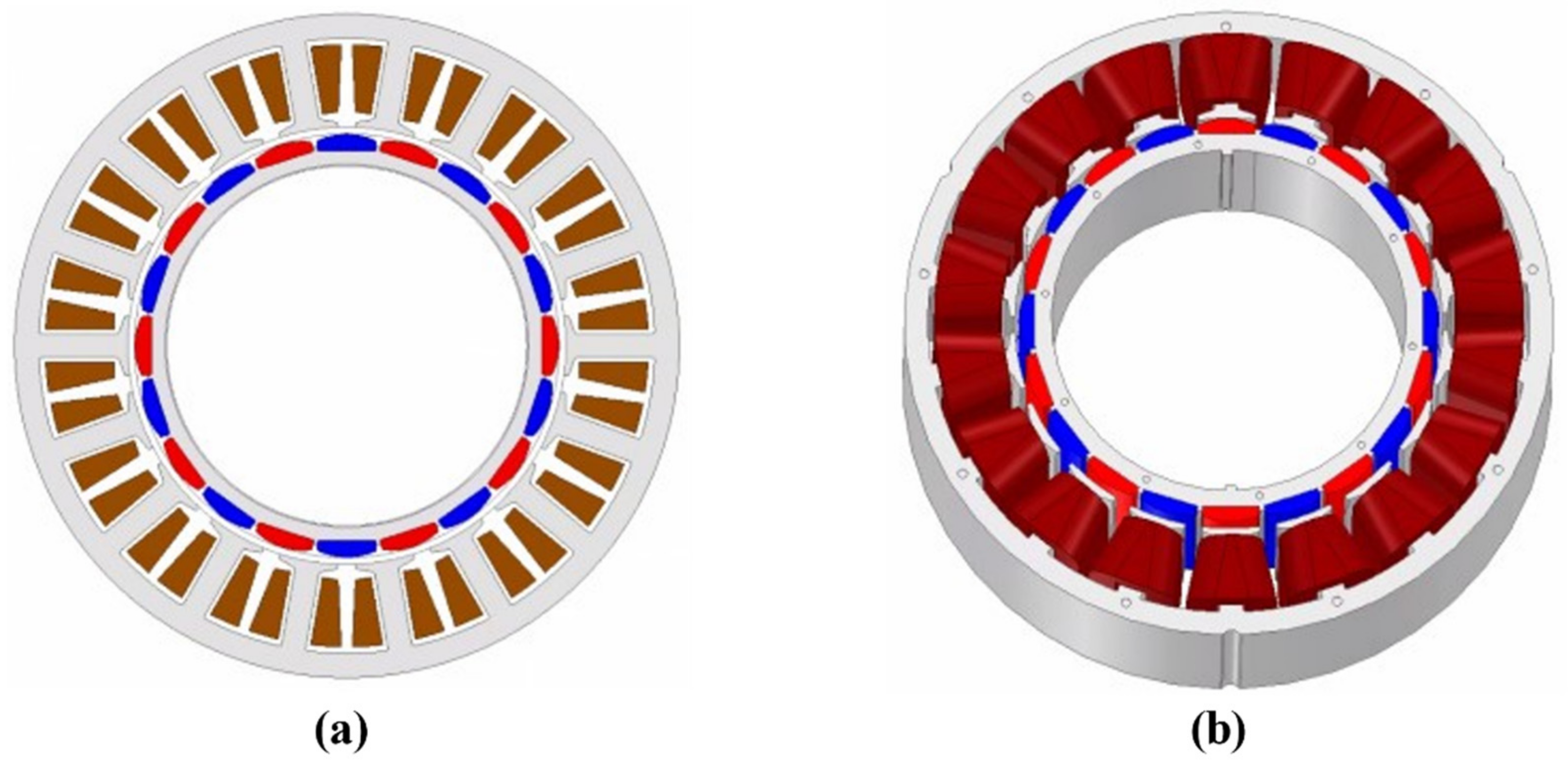


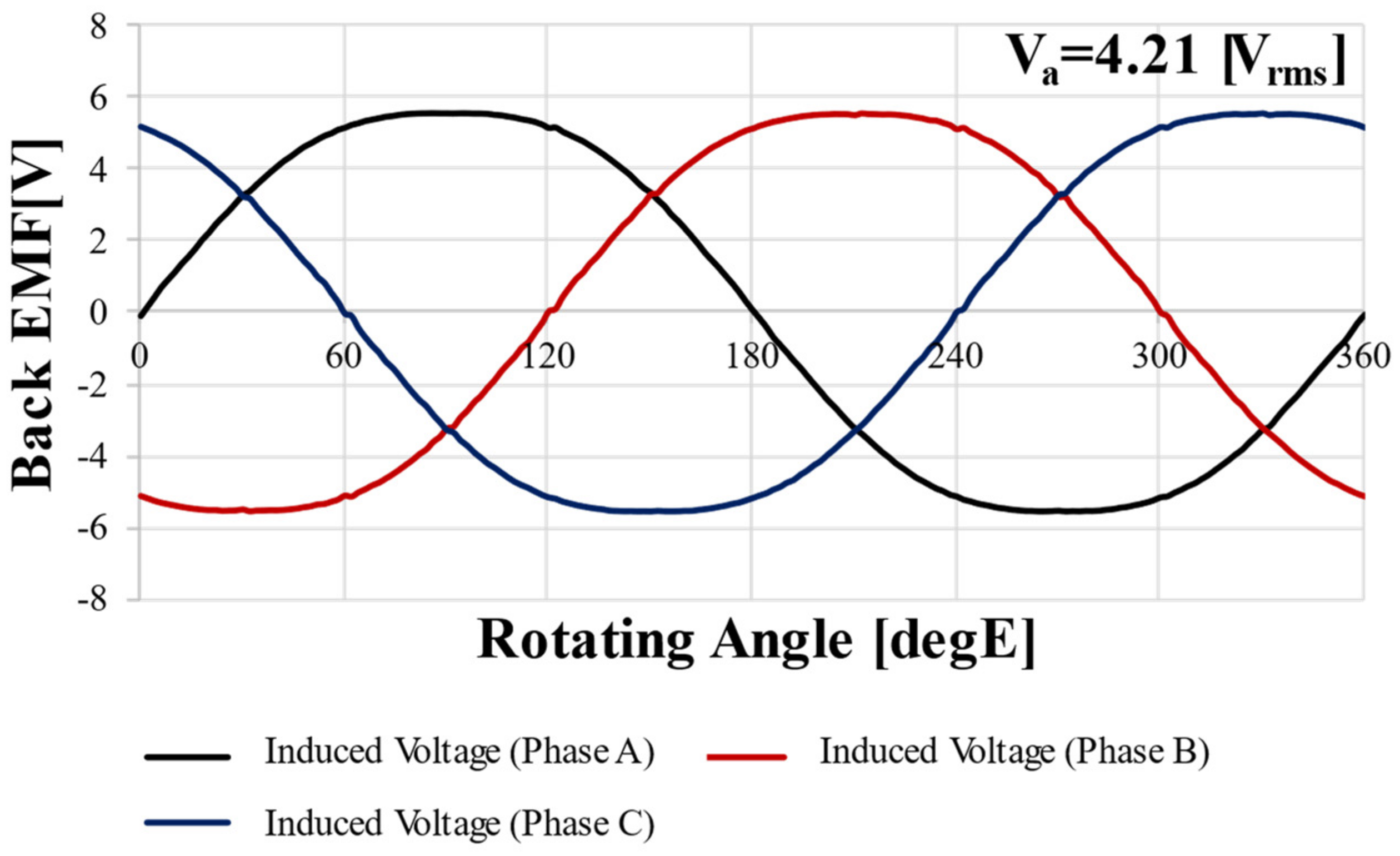
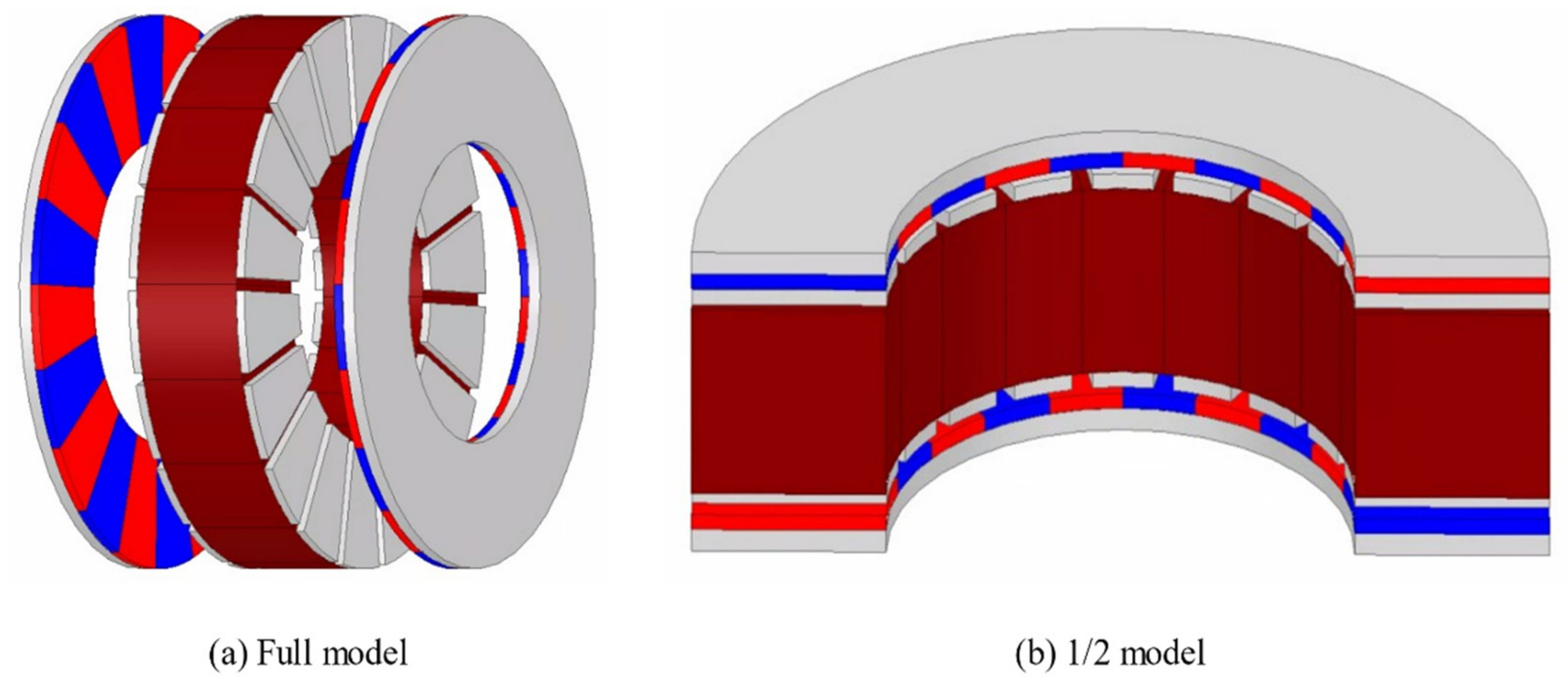
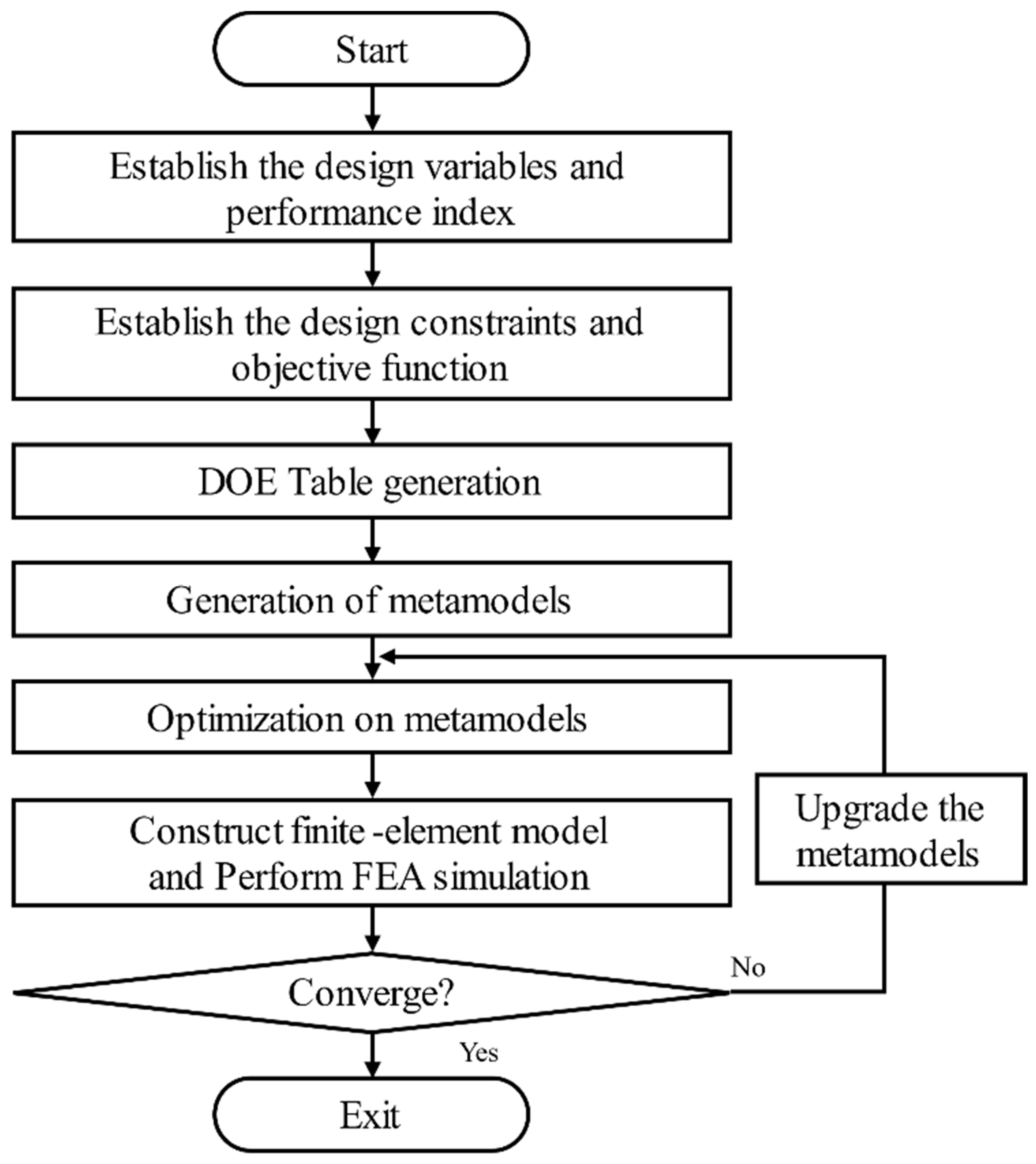



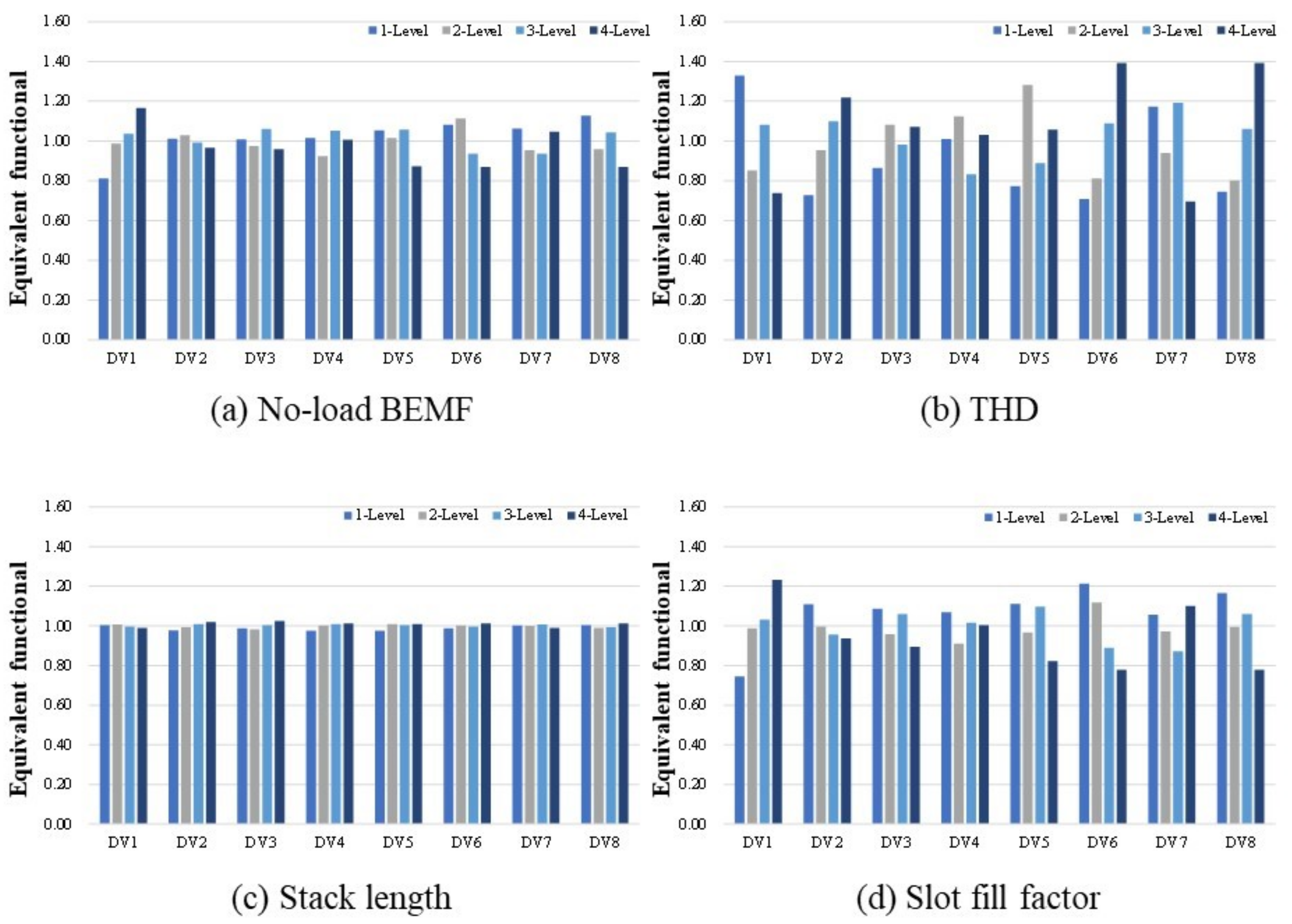

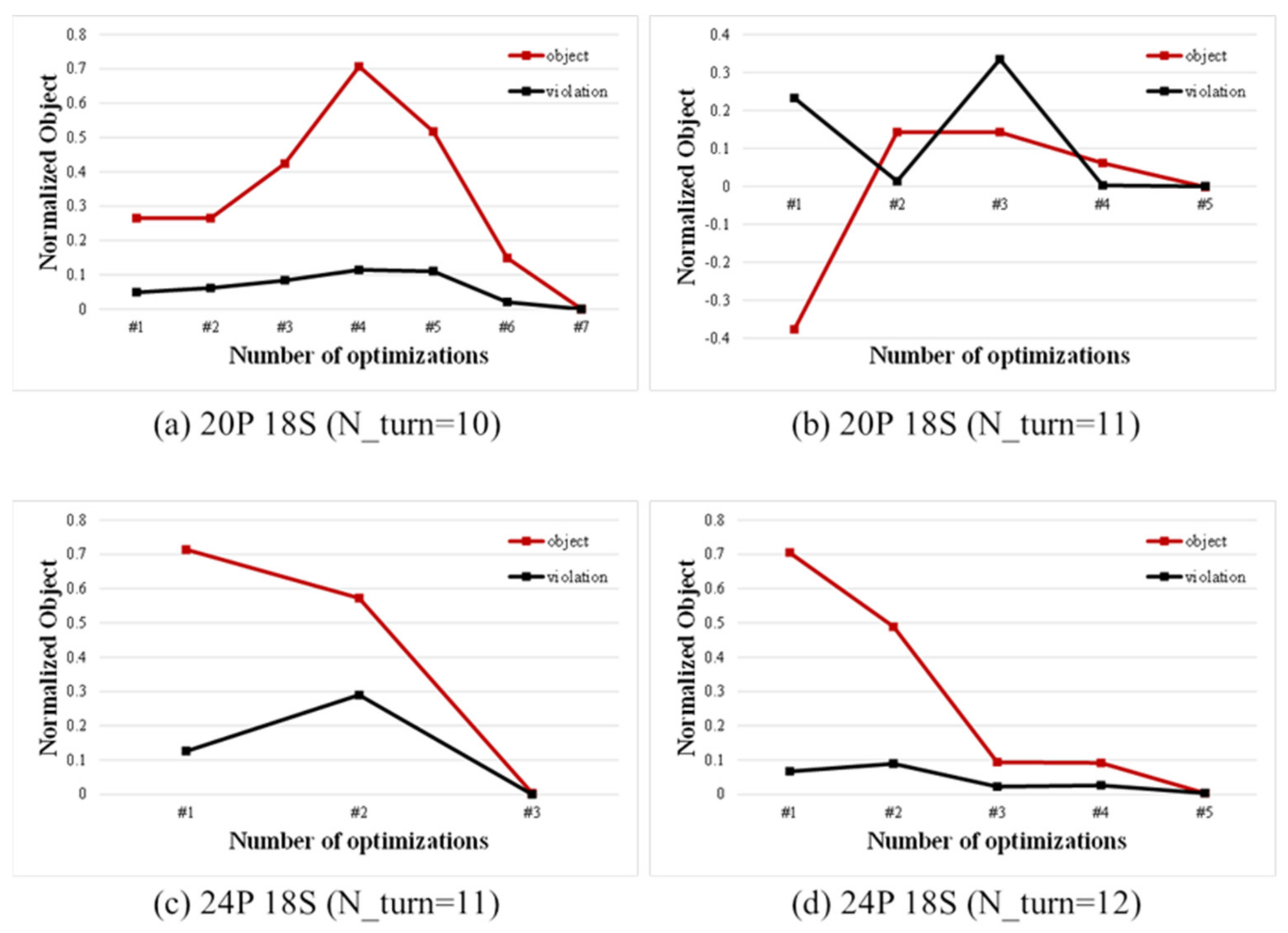
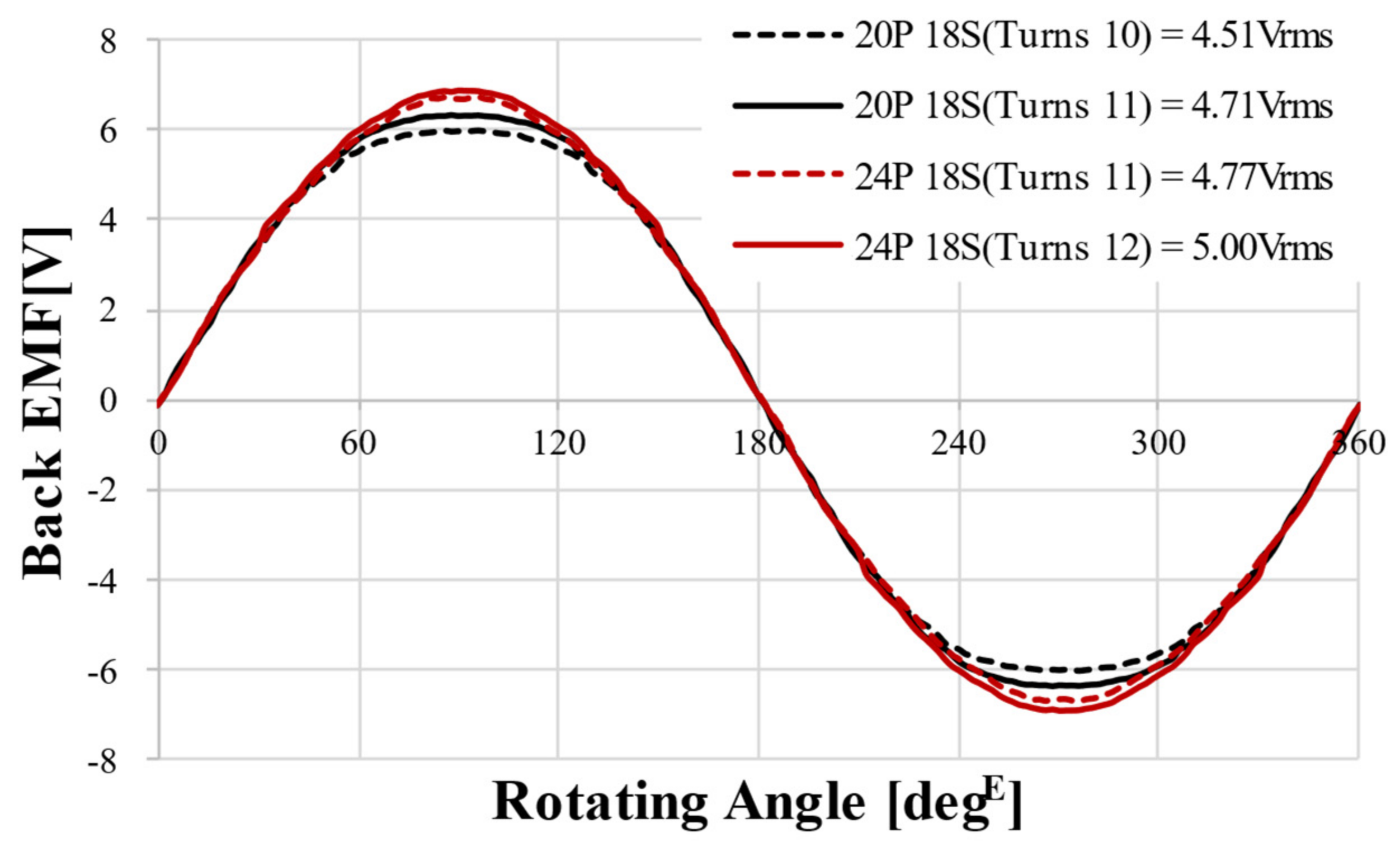
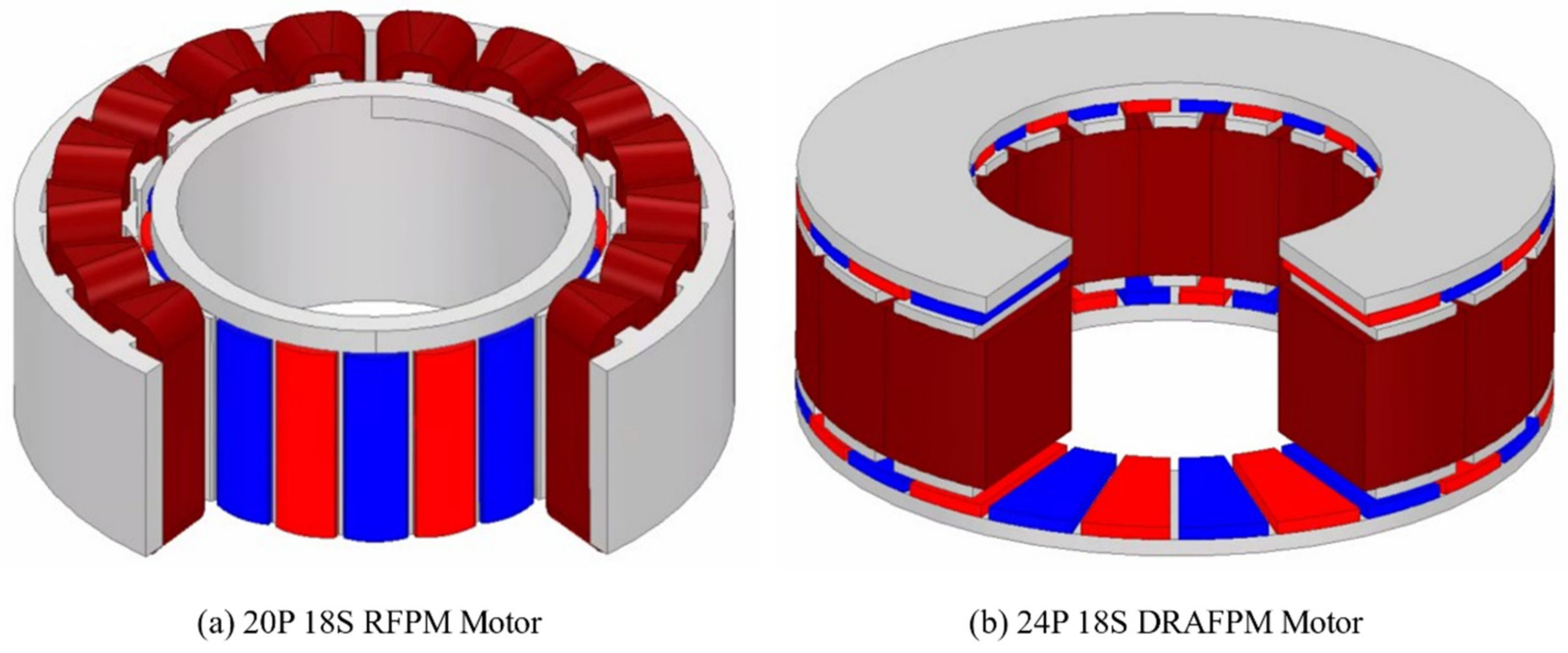
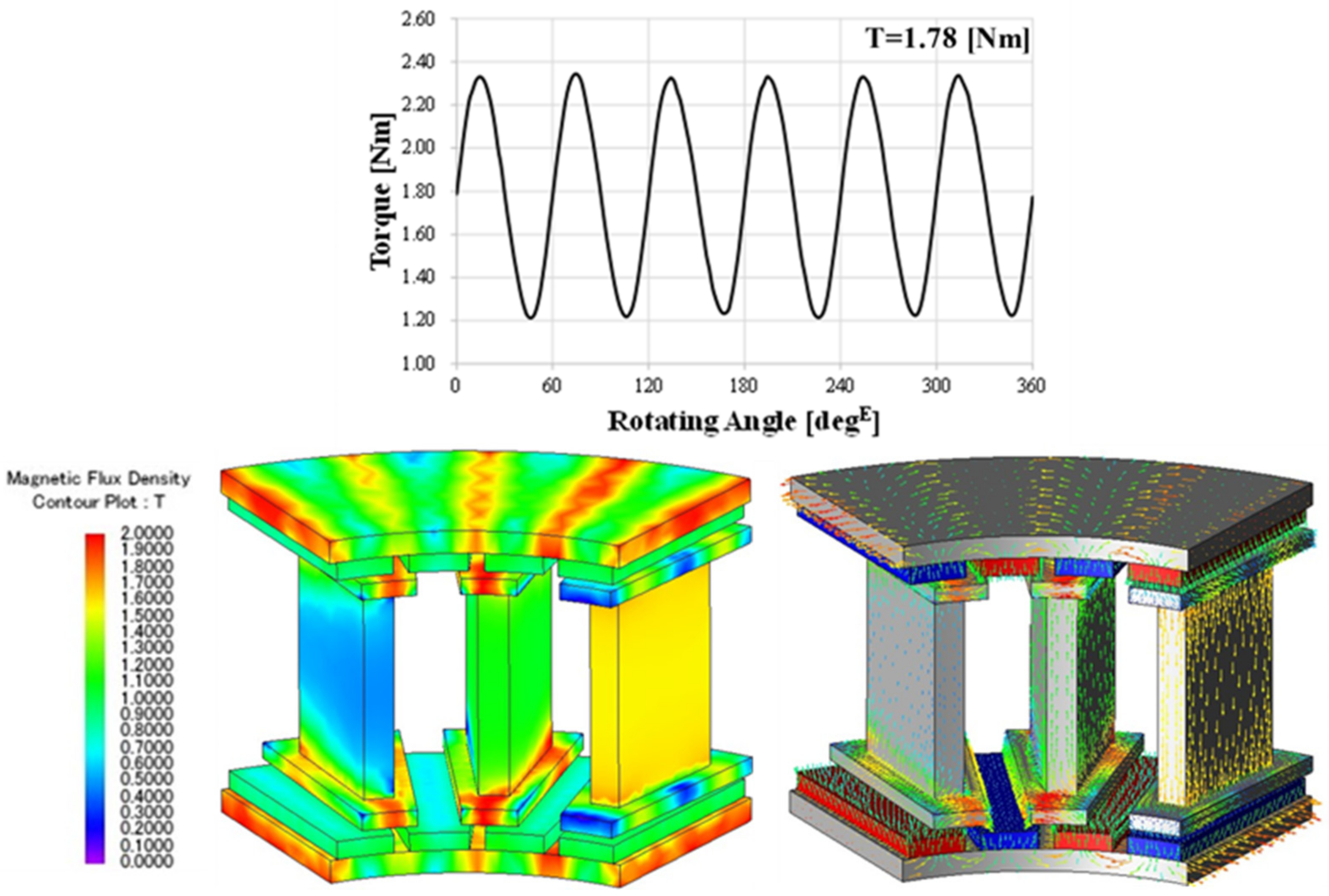
| Parameter | Value2 | Unit |
|---|---|---|
| Poles | 20 | - |
| Slots | 18 | - |
| Rated Power | 500 | W |
| Rated Speed | 3750 | rpm |
| Rated Torque | 1.39 | Nm |
| Rated Current | 12.4 | A |
| Number of Turns | 9 | - |
| Stator Core | 35PN230 | - |
| Permanent Magnet | N42SH | - |
| DV ID | Descriptions | Level | |||
|---|---|---|---|---|---|
| 1 | 2 | 3 | 4 | ||
| DV1 | N_Turns | 9 | 10 | 11 | 12 |
| DV2 | T_Rotor_BY | 1.7 | 1.8 | 1.9 | 2.0 |
| DV3 | T_mag | 1.3 | 1.4 | 1.5 | 1.6 |
| DV4 | T_shoe | 1.1 | 1.2 | 1.3 | 1.4 |
| DV5 | T_teeth | 17.4 | 17.6 | 17.8 | 18 |
| DV6 | T_winding | 2.5 | 2.8 | 3.1 | 3.4 |
| DV7 | G_mag | 1.0 | 1.1 | 1.2 | 1.3 |
| DV8 | G_shoe | 1.2 | 1.4 | 1.6 | 1.8 |
| AR ID | Descriptions | Goal | Limit |
|---|---|---|---|
| AR 1 | BEMF | MAX | - |
| AR 2 | THD | < | 5.51 |
| AR 3 | Stack Length | = = | 28 |
| AR 4 | Fill Factor | = = | 40 |
| RUN | DV1 | DV2 | DV3 | DV4 | DV5 | DV6 | DV7 | DV8 |
|---|---|---|---|---|---|---|---|---|
| N_turns | T_rotor_BY | T_mag | T_shoe | T_teeth | T_winding | G_mag | G_shoe | |
| #1 | 12 | 1.9 | 1.4 | 1.1 | 17.6 | 2.8 | 1.0 | 1.6 |
| #2 | 11 | 1.7 | 1.3 | 1.1 | 17.4 | 2.5 | 1.1 | 1.4 |
| #3 | 11 | 2.0 | 1.6 | 1.4 | 17.6 | 3.1 | 1.2 | 1.2 |
| #4 | 9 | 2.0 | 1.6 | 1.2 | 17.6 | 3.4 | 1.2 | 1.8 |
| #5 | 12 | 1.7 | 1.3 | 1.4 | 17.8 | 2.5 | 1.3 | 1.2 |
| #6 | 10 | 1.9 | 1.6 | 1.3 | 18.0 | 2.8 | 1.1 | 1.4 |
| #7 | 11 | 1.8 | 1.5 | 1.3 | 17.8 | 3.4 | 1.0 | 1.8 |
| #8 | 12 | 1.8 | 1.5 | 1.3 | 17.4 | 2.8 | 1.3 | 1.2 |
| #9 | 10 | 1.8 | 1.4 | 1.2 | 17.4 | 3.1 | 1.2 | 1.6 |
| #10 | 9 | 1.9 | 1.3 | 1.4 | 18.0 | 3.4 | 1.1 | 1.8 |
| #11 | 9 | 1.7 | 1.4 | 1.1 | 18.0 | 3.1 | 1.3 | 1.4 |
| #12 | 10 | 2.0 | 1.5 | 1.2 | 17.8 | 2.5 | 1.0 | 1.6 |
| N_Turns | No-Load BEMF [Vrms] | BEMF Constant (Vmax/krpm) | THD [%] | Stack Length [mm] | Fill Factor [%] | |
|---|---|---|---|---|---|---|
| 20P 18S | 10 | 4.51 | 0.006378 | 5.47 | 28 | 39.48 |
| 11 | 4.71 | 0.006661 | 4.00 | 28 | 40.02 | |
| 24P 18S | 11 | 4.77 | 0.006746 | 1.69 | 28 | 40.00 |
| 12 | 5.00 | 0.007071 | 1.67 | 28 | 40.03 |
| DV1 | DV2 | DV3 | DV4 | DV5 | DV6 | DV7 | DV8 |
|---|---|---|---|---|---|---|---|
| N_turns | T_Rotor_BY | T_mag | T_shoe | T_teeth | T_winding | G_mag | G_shoe |
| 12 [mm] | 1.93 [mm] | 1.49 [mm] | 1.28 [mm] | 17.40 [mm] | 3.29 [mm] | 1.00 [mm] | 1.55 [mm] |
Disclaimer/Publisher’s Note: The statements, opinions and data contained in all publications are solely those of the individual author(s) and contributor(s) and not of MDPI and/or the editor(s). MDPI and/or the editor(s) disclaim responsibility for any injury to people or property resulting from any ideas, methods, instructions or products referred to in the content. |
© 2023 by the authors. Licensee MDPI, Basel, Switzerland. This article is an open access article distributed under the terms and conditions of the Creative Commons Attribution (CC BY) license (https://creativecommons.org/licenses/by/4.0/).
Share and Cite
Yang, S.-H.; Pyo, H.-J.; Jung, D.-H.; Kim, W.-H. A Study on Optimal Design Process of Dual Rotor Axial-Flux Permanent Magnet Synchronous Motors. Machines 2023, 11, 445. https://doi.org/10.3390/machines11040445
Yang S-H, Pyo H-J, Jung D-H, Kim W-H. A Study on Optimal Design Process of Dual Rotor Axial-Flux Permanent Magnet Synchronous Motors. Machines. 2023; 11(4):445. https://doi.org/10.3390/machines11040445
Chicago/Turabian StyleYang, Seo-Hee, Hyun-Jo Pyo, Dong-Hoon Jung, and Won-Ho Kim. 2023. "A Study on Optimal Design Process of Dual Rotor Axial-Flux Permanent Magnet Synchronous Motors" Machines 11, no. 4: 445. https://doi.org/10.3390/machines11040445
APA StyleYang, S.-H., Pyo, H.-J., Jung, D.-H., & Kim, W.-H. (2023). A Study on Optimal Design Process of Dual Rotor Axial-Flux Permanent Magnet Synchronous Motors. Machines, 11(4), 445. https://doi.org/10.3390/machines11040445







